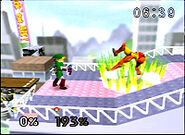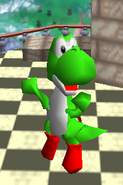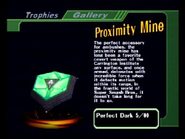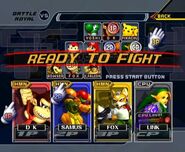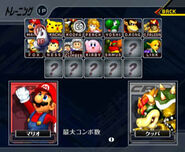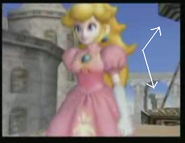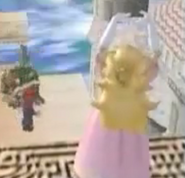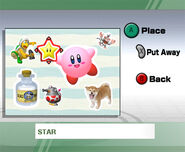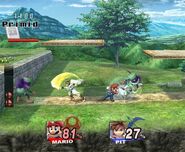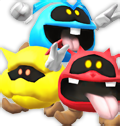Beta Elements are components of the Super Smash Bros. series that, for whatever reason, are removed or altered before that game is released. Known info about beta elements usually comes from one of two sources. The first is information released about a game, by its creators, before the game is complete. The second is data found within the coding of a game that serves no purpose, but could have been implemented into the game at one point.
Super Smash Bros.
Super Smash Bros. was initially developed by Masahiro Sakurai and Satoru Iwata in their downtime, in a form titled 格闘ゲーム竜王 (Kakuto-Gēmu Ryūō, or Dragon King: A Fighting Game), which lacked Nintendo characters. Sakurai, however, felt that the game could not provide the proper atmosphere on a home console without Nintendo characters, and they were soon added and the game was renamed.[1]
Differences In Stages
Dream Land originally had much dark shades including a darker brown on the trees and a darker green for the grass and leaves. There was also taller grass and much more flowers than the final version. Hyrule Castle was also a dark shade of brown and had much more clouds. Saffron City also had much brighter roof colors with the purple and pink trails being brighter.
Scrapped Stages
There were originally two test stages similar to Dream Land. One is labeled as "old" as is similar to a Battlefield stage. The tree in the background is considerably smaller and is growing red fruit. Another stage labeled as "new" is a longer version of the first mentioned stage, but with strange platforms. The platforms seem to be made up of random shapes and it even has invisible platforms.
Fighters
Bowser, Mewtwo, Marth, and King Dedede were originally planned to be playable. Due to the popularity of Mewtwo and Bowser as standalone characters, both were worked on, but were later scrapped.[2] Along with this, Marth and King Dedede were also worked on but were cut along with the previous two due to time constraints. All of the characters (except King Dedede) became playable in Melee. King Dedede later become playable in Brawl.
Final Smashes
Also, according to a recent talk between Masahiro Sakurai and Satoru Iwata, Sakurai revealed he intended to add the Final Smashes in this game; with the proof he already had the voices effects when the characters uses their Final Smash, but for some limitations the Final Smash had to wait 9 years until the launch of Brawl.[3] In fact, just a few of these sound effects are already in the game, but as mentioned, were never used. These sounds include Ness yelling, "PK Starstorm!", Pikachu charging energy, and Captain Falcon saying, "Come on!" and "Blue Falcon!" Other characters heard include Fox, Kirby and Link.
Unused Announcer Clips
There are three unused Announcer voice clips: "Are you ready?" "Final Stage" "Bonus Stage" and an unnamed Fanfare.[4]
Unused Audio
(BGM#11) A brief fanfare, it was probably going to be used as a standard victory theme for all the characters, this was replaced by giving a victory theme to every character, based on the universe they're from. The following are unused Final Smash clips, recorded for some characters, most of them are divided in two clips: A metallic friction sound and Samus shooting a projectile of ambiguous description with her Arm Cannon. Both of these sounds still exist in Melee.
Kirby making an odd grunt and yelling, separated in two sounds.
Fox saying "ike!", a Japanese term usually translated as either "come on" or "let's go". Was probably going to be the Landmaster afterwards…
Pikachu saying "Pika..." and hoarsely "chuuuuu!" separated in two sounds. This would later return in Brawl for its Final Smash, Volt Tackle, though these sound clips clearly weren't intended for that particular move; Volt Tackle is based on a move originated from Pokémon Ruby and Sapphire, released nearly four years after the game's release.
Captain Falcon saying "come on!" It was re-recorded for Melee but kept as an unused sound, then used in Brawl as part of his Final Smash and a taunt, and only present in the Japanese version, "Blue Falcon!". This line was alsos re-recorded for Melee, where this sound was once again unused, and finally used in Brawl as a part of his Final Smash. It may also have been intended for his animation of entering the stage, when he exits the Blue Falcon.
Ness saying "PK" and "Starstorm!" separated in two sounds. This concept and sounds would later return in Brawl as his Final Smash.
Super Smash Bros. Melee
Differences In Stages
Many stages had different layouts or designs in early screenshots of Melee. Below is a list of layout or design changes:
- Yoshi's Story originally had a much more different layout with the right side of the stage being formed much rougher. There were also 4 floating platforms with 2 platforms for each side of the stage.
- Temple originally had scrapped brown platforms and other moving platforms on the right side of the stage.
- Jungle Japes originally had larger gray platforms and a slightly different background.
- Great Bay originally had smaller platforms on the water and the background laboratory was supposed to be a solid platform that could be walked on and through.
- Fountain Of Dreams originally had much darker colors and also had two platforms instead of three which were both lower placed.
- Yoshi's Island was larger in its original version with more Rotating Blocks, scrapped Note Blocks, and bigger size in general.
- Green Greens originally had much darker colors, rougher textures underneath the platforms, and the Star-Blocks and Bombs could originally be stacked in rows of 4 instead of the final 3.
- Rainbow Cruise originally had more clouds and a darker sky. The ship that floats around the stage also had a different design.
- Pokémon Stadium originally had a blank screen in the background. However, later screenshots show it with type symbols from the Pokémon TCG, possibly used when the stage shifted forms.
- Fourside originally had black-and-white lights and buildings instead of multi-colored lights.
- Mushroom Kingdom originally contained aspects from the original stage in 64 where pipes were included.
Scrapped Stages
The game originally had 10 starter stages: Princess Peach's Castle, Kongo Jungle. Great Bay, Brinstar, Yoshi's Story, Fountain of Dreams, Corneria, Pokémon Stadium, Mute City, and Onett.[5]. There is also code for several scrapped stages. Below is a list of scrapped stages:
- Code by the name of "AKANEIA", which may have been intended to be a Fire Emblem stage, due to the code sharing the name of the continent in Fire Emblem: Shadow Dragon and the Blade of Light. This is also proven with the introduction of Marth and Roy in Melee. It may have been reintroduced in Brawl in the form of Castle Siege.
- Code by the name of "ICETOP", which may have been intended to be a second Ice Climbers stage, due to most series having two stages (such as the EarthBound series having Onett and Fourside or the Pokémon series having Poké Floats and Pokémon Stadium).
- Code by the name of "TSEAK", which may have been intended to be Sheik's Target Test. It may have been scrapped because Zelda and Sheik are considered one character in Melee.
- Code by the name of "DUMMY", which may have been meant to be a test stage or platform.
- Code by the name of "TEST", which involves a large stage with a café background. The music is the same as Fox and Falco's stage, Corneria. This may have been used as a test stage or platform.
Fighters
Most fighters were considered to be in the game, mostly including NES characters, which was eventually taken by Ice Climbers and also for clone fighters such as Dr. Mario and Ganondorf, among others. Below is a list of considered characters that were cut:
- Wario, which was highly considered after his popularity. Sakurai even stated in a questionnaire that he would've added Wario if he had time and space to make another character. Wario later became playable in Brawl.
- Lucas, which was meant to replace Ness, but was cut due to Mother 3's cancellation for the Nintendo 64. Lucas later became playable in Brawl.
- Snake, which was considered by Sakurai's friend, Hideo Kojima. At the time of the request, Melee was too far in development for any kind of fighters to be coded in. Snake later became playable in Brawl.
- Sonic, which was considered by Yuji Naka, former head of the Sonic Team. Sonic later became playable in Brawl.
- Balloon Fighter, which was meant to be the NES representation.
- The Urban Champion Fighter, which was meant to be the NES representation.
- Bubbles from Clu Clu Land, which was meant to be the NES representation.
- Excitebiker, which was meant to be the NES representation.
- Ayumi Tachibana, which was cut because it may not have been familiar to a US audience.
Debug-Menu Fighters
Through the Debug-Menu, Giga Bowser, both male and female Fighting Wire Frames, Master Hand, Crazy Hand, and even Sandbag are all playable (to a limited extent). They can also interact with certain items such as the Metal Box.
Items
Early screenshots showed the Motion-Sensor Bomb to be much different; these screenshots actually showed it to be a Proximity Mine from Perfect Dark rather than the Motion-Sensor Bomb from "TOP SECRET" (actually GoldenEye 007) that appeared in the final game. A screenshot of this Proximity Mine's trophy has also been released, revealing that the text in the Proximity Mine trophy was altered slightly (removing references to Perfect Dark) for the final Motion-Sensor Bomb trophy. The reason the Perfect Dark Proximity Mine was changed to a GoldenEye 007 Motion-Sensor Bomb remains unknown, though the fact that Nintendo hid the trophy's debuting game entry with the words "TOP SECRET" suggests that it may have had to do with copyright infringement. There was also planned to a PokéBall summon for the Pokémon Ditto. Its original intent was to copy its summoner and act as an additional fighter. It was scrapped due to its difficult code, but Ditto later reappeared in Ultimate, reusing its scrapped purpose in Melee.
Unused Audio
(FF_BAD.HPS) An unused fanfare. It might have been used when failing a Bonus Stage, note that the prefix "FF" probably means "fanfare".
(FF_GOOD.HPS) Another unused fanfare similar to the one above. Was probably used at one point in development for when a Bonus Stage was won.
(FF_STEP1.HPS) A fanfare. The term "Step" is also used internally in Brawl to refer to the music used in the Subspace Emissary mode (and for a few cut tracks in the same stead), and the themes used in the Subspace levels are referenced as such in the game's sound test. Consequently, these themes were very likely intended for either Classic or Adventure.
(FF_STEP2.HPS) Another one following the one above.
(FF_STEP3.HPS) Yet another fanfare following the one above.
(S_NEW2.HPS and SFX_FPON_NEWFANF2) Can be accessed in the Sound Test as "Rare Trophy!", but is still unused. Take note that a remastered version of this fanfare is used in Brawl, and was remastered again as the character unlock sound in SSB4.
(SFX_PKV_METAMAN) Ditto crying "Mon-mon!" (Ditto's Japanese name), who would've come out of a Poké Ball. This can be listened to via debug mode when forced to spawn a Poké Ball with Ditto.
(SFX_IT_CLOCKBOMB_COUNT) A looping ticking sound. Its file name suggests it was for an early item that would have exploded after some sort of countdown.
(SFXNR_HOWTOPLY) The announcer saying "How to Play!" This can be listened to in the Sound Test, not requiring any debugging, but it's still unused. NR most likely stands for Narrator.
(SFXNR_AND) The announcer saying "And!" It can be listened to in the Sound Test, not requiring any debugging, but it's still unused. Most likely used in Classic mode for challenging two opponents, this concept eventually went used in Brawl.
(SFXNR_WINS) The announcer saying "Wins", which in first game was used during Team Battles "Red/Blue/Green Team Wins!"). It can be listened to in the Sound Test, not requiring any debugging, but it's still unused.
(SFXV_CAPTAIN_BLUEF) Captain Falcon saying Blue Falcon!, this one existed (but remained unused) in the Japanese version of the first game, and would've later be used in Brawl as his Final Smash quote.
(SFXV_CAPTAIN_COMEON) Captain Falcon saying "Come on!" This would later be used as a taunt (and part of his Final Smash) in Brawl.
(SFXV_DRMARIOB_2BIG) Clone leftovers. It's Mario's taunt sound.
(SFXV_DRMARIOB_2BIG) A lower-pitched version of the above.
(SFXV_DRMARIOS_2BIG) A higher pitched version of the above.
(SFXV_LUIGI_2BIG) (SFXV_LUIGIB_2BIG) (SFXV_LUIGIS_2BIG)
The same set of sounds for Luigi, but different-pitched and different speed.
(SFXV_GANON_KIRIFUDA) Ganondorf yelling angrily. This clip can be heard in the Sound Test without using any debugging routines. "Kirifuda" (Japanese: 切り札 or 切札) means a "trump card" or "last resort" in Japanese, strongly suggesting that it could've been for a Final Smash, whose Japanese name, Saigo no Kiri Fuda (最後の切りふだ), translates to Final Trump Card. Oddly, it would eventually end up being used in Brawl as the Wii Remote sound effect played when selecting Ganondorf.
(SFXV_MARIO_KIRIFUDA) Mario's trademark "Let's-a-go" (when choosing a Star in Super Mario 64) which was pitched up for Luigi in this game, as one of his Victory Poses. The use of "kirifuda" in the filename, similarly to Ganondorf's clip above, implies it may have been intended for a Final Smash back when they were still being considered in development.
(SFXV_MARS_LETSDANCE) Marth saying "Let's dance!" Sounds like something that would be used for a taunt, or possibly a Final Smash (but note it lacks KIRIFUDA). Even if it was used, it wouldn't fit on him since all of his lines in the game are in Japanese.
(SFXV_PIKACHU_SUTEMI) An audio clip of Pikachu yelling ferociously. Can be listened to via the in-game Sound Test. "Sutemi" is a Judo technique which involves throwing an opponent while the user is positioned on their back or sides, so this was likely intended for Pikachu's backwards throw, itself an exaggerated depiction of the move, though.
(SFXV_PICHU_SUTEMI) The same one for Pichu, the way to find it is the same as the one above.
(SFXNR_ZAKOTEAM) The announcer saying "Fighting Wire Frames!". It can be listened to in the Sound Test, not requiring any debugging, but it's still unused.
(SFXNR_GIGAKOOPA) The announcer saying "Giga Koopa". It can be listened to it in the Sound Test if the language is set to English, not requiring any debugging, but it's still unused.
(SFXNR_GIGABOUCER) The announcer saying "Giga Bowser". It can be listened to it in the Sound Test if the language is set to Japanese, not requiring any debugging, but it's still unused. Curiously, the filename reads BOUCER instead of BOWSER.
(SFXNR_MASTERHANDS) The announcer saying "Master Hand". It can be listened to it in the Sound Test, not requiring any debugging, but it's still unused, since there's no VS screen for Master Hand in Classic Mode.
Super Smash Bros. Brawl
Stages
Though there aren't any scrapped stages, there are some scrapped materials for some stages. In early screenshots, Battlefield is shown without any platforms. Similarly to Melee's Pokémon Stadium, Pokémon Stadium 2 doesn't show any visuals on its background screen. There may have also been intent for the top of Shadow Moses Island to be accessed, as early screenshots show Snake on the stages roof texture. Also, the stages Summit, Rainbow Cruise, and Halberd were originally named The Summit, Rainbow Ride, and Battleship Halberd respectively.
Fighters
Multiple character were considered for Brawl, even including a famous Forbidden 7, made up of code for extra fighters. Below is a list of considered fighters and the Fobidden 7:
- Miis were considered, but was cut due to Sakurai stating "it didn't seem right at the time for Miis to be punching and kicking". It may have also been scrapped due to the Miis customizable status, which may have included problems online between players. Miis later became playable in Smash 4.
- Pac-Man was considered by Shigeru Miyamoto, but Sakurai stated that his shape was strange and too far-fetched to become a fighter. Pac-Man later became playable in Smash 4.
- Villager from Animal Crossing was considered, but was cut due to Sakurai stating that the character was "not suited for battle". Villager later became playable in Smash 4.
- Krystal from Star Fox was considered, but was suggested late into the game. Wolf was considered over Krystal as the Star Fox representation as Wolf was easier to model after Fox.
- Geno was considered due to his popularity, and Sakurai even stating that his design would be fitting for the series. However, Geno was cut due to copyright rights with Square Enix.
- Blastoise was considered for Pokémon Trainer instead of Squirtle early on in development. Blastoise was scrapped so that Pokémon Trainer could feel more balanced for every Pokémon, and not all of them being fully-evolved.
The Forbidden 7
Due to Super Smash Bros. Brawl's extensive development time and changes in the design, various pieces of code were left unfinished within the game. Several cut characters have been discovered this way along with some music tracks. The characters cut are sometime colloquially known as the "Forbidden 7." Below are explanations for the lost code and music.
Characters
- Code under the name of "mewtwo", which was planned to be Mewtwo.
- Code under the name of "roy", which was planned to be Roy.
- Code under the name of "dr_mario", which was planned to be Dr. Mario.
- Code under the name of "dixie", which may have been planned for Dixie Kong. Dixie Kong and Diddy Kong's code are placed together, which may have meant they may have been one fighter represented with two characters, similarly to Ice Climbers and they may have been able to switch between each other, similarly to Donkey Kong Country 2.
- Code under the name of "Pra_Mai", which may have been planned for Plusle & Minun or a Random section. The definite identity of the code is often argued about due to its strange name. The code may have been for Plusle & Minun, two Electric-type Pokémon from Generation III, seeing how the past two games, 64 and Melee, both also had Electric-type rodent Pokémon (64 had Pikachu, which debuted in Generation I and Melee had Pichu, which debuted in Generation II). There is also another theory stating that it may have been an extra Random section as "Pra" can roughly translate to "player" and "Mai" also roughly translates to "every", possibly stating that square may have included every fighter or it could randomize every fighter.
- Code under the name of "toon_zelda" and "toon_sheik", which may have been planned to be Toon Zelda and Toon Sheik, similarly how Zelda can shift between Shiek in Brawl, along with the addition of Toon Link. However, due to Toon Link being a very late character in development, this may have been scrapped due to time.
Icons
Some of the game world icons were initially the same as in the previous two games, but they were revised as time went on (Mario's Mushroom icon was refined and given spots, the Poké Ball icon has the top half colored in to properly represent how it is usually red, etc.).
Moves
Wario Bike, Drill Rush, and "The Flowers That Bloom in the Echoes" were originally called Wario Chopper, Triple Dash, and, "Flowers Bloom on the Notes" respectively. Snake's grab was originally more accurate, shown in a beta picture with him holding Ike's arm behind his back and covering his mouth. When Snake grabs Sonic, Sonic puts his arm behind his back, showing that his animation was not changed to reflect Snake's current grab. In addition, all of Snake's throws put the character being thrown in the follow up for this animation. This can be seen by pausing immediately after executing a throw as Snake. Another beta element in Brawl was Kirby's Hammer move. When he uses hammer in mid-air in SSBM, he does a vertical spin; in SSBB, however, he does a horizontal spin. This was seen in the first trailer, where he does the former. Also seen in the first trailer is Zero Suit Samus' weapon. Instead of using her whip, she appears to be using a lightsaber-like weapon. In the second trailer, when Fox appears, he has his Blaster in his hand during the whole battle despite the fact that in the final release he only uses the blaster when using his standard special move. Another beta element is Link's up-special move, that in the first and second trailer is shown doing more than one cut in the air/earth, like in SSBM. Another changed element is Pikachu's up-special move, in the first trailer it's shown making two "beep" sounds when he gets teleported. However, in the final version the sound from his up special move is different and it makes just 1 sound in the first teleport. In the E3 2006 Trailer, many minor differences to the final version were seen. One of which was Mario's Up Tilt, being slightly faster than the old version.
Trophies
The characters Mario, Luigi, Donkey Kong, Diddy Kong, Zero Suit Samus, Falco, King Dedede, Sheik, Zelda, Lucario, Pikachu, Jigglypuff, Pokémon Trainer, Snake, Pit, and Captain Falcon all had different trophy designs before they got their final in-game versions.[6] There are also unused trophy designs for Donkey Kong Jr., Party Monkey and Dread Kong from DK Jungle Beat, and Samurai Goroh.
Textures and Animations
By examining the textures of certain characters, it appears as if visible battle damage was at one point planned to be in the game, as evidenced by such unused textures as a Meta Knight mask texture with large gashes over the eye slot and a cracked visor for Captain Falcon. This later made a return in Ultimate were various characters such as Little Mac can have visual bruises when taking damage. Other oddities within the textures include textures for Link's Ordon Sword from Twilight Princess as well as its sheath. Also, many characters had unused animations, such as Kirby charging and swinging his Hammer (which was later used in Wii U/3DS), Diddy Kong laughing mischievously in both ground and air, possibly used when a opponent slips on a Banana Peel that he dropped, Wolf using Fox's infinite kick combo, and some unused jump, fall, and landing animations of Pokémon Trainer.[7] Solid Snake was also meant to be more muscular, and was to have a gray suit rather than blue; along with this, his down smash mine looked different.
Subspace Emissary
There were scenes taking place before the events of the Subspace Emissary where the Subspace Army takes over the Halberd and King Dedede unintentionally stalls Meta Knight from preventing it from happening. Masahiro Sakurai confirmed that he decided to cut this out and an update was made to confirm this together with how various events and characters in the Subspace Emissary comes together. Also, Mario was the one seen fighting Petey Piranha in one of the Super Smash Bros. Brawl TV spots instead of Kirby.
Music
There are several unused pieces of music in the games files. Along with this, the description for the My Music options originally said, "Adjust how often a song will appear on this stage." It has since been revised in a general tone to say, "Adjust how often songs appear on stages." Along with this, one piece of music that was planned for the Delfino Plaza stage was later moved to Luigi's Mansion. Below is a list of unused songs:
- "MORONOKO" (Uncertain Super Mario game)
- Hippie Battle (MOTHER)
- The Loner, Falco Lombardi (Star Fox Command)
- Ballad of the Windfish (The Legend of Zelda: Link's Awakening)
- Eight Melodies (MOTHER)
- Boss Battle (Mario & Luigi: Partners in Time)
- Type A (Yoshi's Cookie)
- Smiles and Tears (EarthBound/Mother 2)
- Because I Love You (EarthBound / Mother 2)
- Radio Exercises (Animal Crossing/Animal Forest)
- Famicom Sports Medley (Baseball/Golf/Ice Hockey/Tennis)
- Special Trax (Stunt Race FX/Wild Trax)
- Main Theme (Metal Gear Solid 2: Sons of Liberty)
- Metal Gear Solid Big Beat Mix (Beatmania)
- You Can Do Anything (Sonic CD, JP version)
- The Chosen Ones (Fire Emblem: Shadow Dragons and Blade of Light)
- Move Out! (Fire Emblem: Path of Radiance)
Assist Trophies
- Ridley was originally intended to be an Assist Trophy but was changed to a boss in the Subspace Emissary.
Super Smash Bros. for Nintendo 3DS/Wii U'
Stages
In the code for Mario Circuit, there are textures for a blue toad, which may have been used for racers along the track or possibly an audience of toads watching the fighters. Also, the Flying Men that appear in Magicant had full 3D models, but were replaced with their old 2D sprites to save code space. There were also two reworked stages of Kirby's Epic Yarn and Super Mario Land that were later reworked into The Great Cave Offensive and Dream Land. The Kirby's Epic Yarn stage may have been reworked so it wouldn't be confused with Woolly World, but the reason for changing Super Mario Land into Dream Land is unknown. There are also unused aspects of a Dr. Mario and Swapnote stage as there are unused boss icons for Dr. Mario viruses and there is also code by the name of "diary", which is part of Swapnote's Japanese name. There is also code with the names "braintraining" and "plankton", possibly showing that a Brain Age stage would be introduced and Hanenbow (or a new Electroplankton stage) would come back from Brawl.
There are also visual changes to certain stages that didn't get cut. Some examples are Boxing Ring, which originally had much brighter lighting, and Windy Hill Zone, which originally didn't have animals in the background of the stage.
Fighters
Some characters were considered but were cut due to the space of the 3DS console, as Sakurai wanted both the Wii U version and the 3DS versions to have the same roster. Below is a list of cut characters:
- Ice Climbers were considered to return from Brawl, but the 3DS's data space was too small to support the two characters.
- Through datamining, a Rhythm Heaven character was meant to be included. Not much is known about the character except for it has a spot of code in the roster.
- Alph was considered to be his own character and would also use Rock Pikmin, but was turned into a reskin for Olimar due to time constraints.
- Takamaru was considerd to be a fighter, but resulted in an Assist Trophy due to the lack of fan familiarity.
- Heihachi Mishima was considered, but was cut because his moves were considered too difficult to implement. However, he did become a Mii Brawler costume in the DLC.
- Chrom was considered, but was left out in favor for Robin, as Sakurai stated that Chrom may have not been unique enough as he was too similar to Marth & Ike. Chrom later became playable in Ultimate.
Certain characters that are considered clones were also originally placed as their own characters. Some of these characters include Lucina, Dr. Mario, and Dark Pit.
Trivia
- Captain Falcon's polygon model in 64 highly resembles the models of the characters in Dragon King: The Fighting Game.
See also
External links
References
- ↑ Wii.com (Accessed on 9-18-08)
- ↑ "Most wanted" poll from Japanese SSB64 website
- ↑ [1]
- ↑ YouTube - Super Smash Bros. unused sounds (Accessed on 11-22-2009)
- ↑ Smash Bros. Melee: Onett beta music.
- ↑ Source
- ↑ [2]



